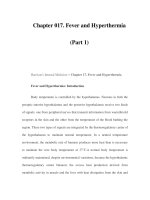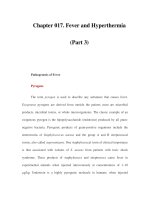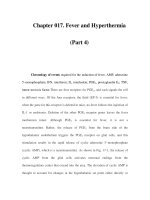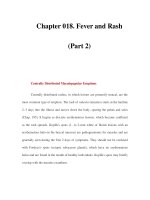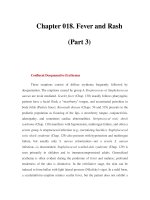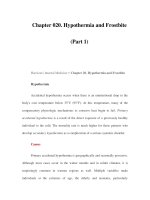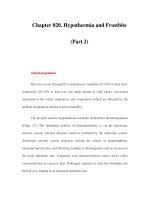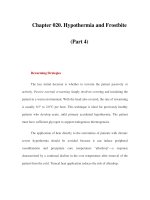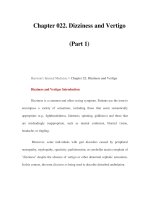Chapter 071. Vitamin and Trace Mineral Deficiency and Excess (Part 1) pot
Bạn đang xem bản rút gọn của tài liệu. Xem và tải ngay bản đầy đủ của tài liệu tại đây (45.66 KB, 8 trang )
Chapter 071. Vitamin and Trace Mineral
Deficiency and Excess
(Part 1)
Harrison's Internal Medicine > Chapter 71. Vitamin and Trace Mineral
Deficiency and Excess
Vitamin and Trace Mineral Deficiency and Excess: Introduction
Vitamins and trace minerals are required constituents of the human diet
since they are either inadequately synthesized or not synthesized in the human
body. Only small amounts of these substances are needed for carrying out
essential biochemical reactions (e.g., acting as coenzymes or prosthetic groups).
Overt vitamin or trace mineral deficiencies are rare in Western countries due to a
plentiful, varied, and inexpensive food supply; however, multiple nutrient
deficiencies may appear together in persons who are chronically ill or alcoholic.
Moreover, subclinical vitamin and trace mineral deficiencies, as diagnosed by
laboratory testing, are quite common in the normal population—especially in the
geriatric age group.
Famine, emergency-affected and displaced populations, and refugees are at
increased risk for protein-energy malnutrition and classic micronutrient
deficiencies (vitamin A, iron, iodine), as well as for thiamine (beriberi), riboflavin,
vitamin C (scurvy), and niacin (pellagra) overt deficiencies.
Body stores of vitamins and minerals vary tremendously. For example,
vitamin B
12
and vitamin A stores are large, and an adult may not become deficient
for 1 or more years after being on a depleted diet. However, folate and thiamine
may become depleted within weeks when eating a deficient diet. Therapeutic
modalities can deplete essential nutrients from the body; for example,
hemodialysis removes water-soluble vitamins, which must be replaced by
supplementation.
There are several roles for vitamins and trace minerals in diseases: (1)
deficiencies of vitamins and minerals may be caused by disease states such as
malabsorption; (2) both deficiency and excess of vitamins and minerals can cause
disease in and of themselves (e.g., vitamin A intoxication and liver disease); and
(3) vitamins and minerals in high doses may be used as drugs (e.g., niacin for
hypercholesterolemia). The hematologic-related vitamins and minerals (Chaps. 98,
100) are considered only briefly in this chapter, as are the bone-related vitamins
and minerals (vitamin D, calcium, phosphorus; Chap. 346), since they are covered
elsewhere (Tables 71-1, 71-2, and Fig. 71-1).
Table 71-1 Principal Clinical Findings of Vitamin Malnutrition
Nutrient Clinical Finding
Dietary
Level per Day
Associated
with Overt
Deficiency in
Adults
Contributing
Factors to Deficiency
Thiamine Beriberi:
neuropathy, muscle
weakness and wasting,
cardiomegaly, edema,
ophthalmoplegia,
confabulation
<0.3
mg/1000 kcal
Alcoholism,
chronic diuretic use,
hyperemesis
Riboflavin
Magenta tongue,
angular stomatitis,
<0.6 mg
—
Nutrient Clinical Finding
Dietary
Level per Day
Associated
with Overt
Deficiency in
Adults
Contributing
Factors to Deficiency
seborrhea, cheilosis
Niacin Pellagra:
pigmented rash of sun-
exposed areas, bright red
tongue, diarrhea, apathy,
memory loss,
disorientation
<9.0
niacin
equivalents
Alcoholism,
vitamin B
6
deficiency,
riboflavin deficiency,
tryptophan deficiency
Vitamin
B
6
Seborrhea,
glossitis convulsions,
neuropathy, depression,
confusion, microcytic
<0.2 mg
Alcoholism,
isoniazid
Nutrient Clinical Finding
Dietary
Level per Day
Associated
with Overt
Deficiency in
Adults
Contributing
Factors to Deficiency
anemia
Folate Megaloblastic
anemia, atrophic
glossitis, depression,
homocysteine
<100
µg/d
Alcoholism,
sulfasalazine,
pyrimethamine,
triamterene
Vitamin
B
12
Megaloblastic
anemia, loss of vibratory
and position sense,
abnormal gait, dementia,
impotence, loss of
bladder and bowel
control, homocysteine,
<1.0
µg/d
Gastric atrophy
(pernicious anemia),
terminal ileal dise
ase,
strict vegetarianism,
acid reducing drugs
(e.g., H
2
blockers)
Nutrient Clinical Finding
Dietary
Level per Day
Associated
with Overt
Deficiency in
Adults
Contributing
Factors to Deficiency
methylmalonic acid
Vitamin C
Scurvy:
petechiae, ecchymosis,
coiled hairs, inflamed
and bleeding gums, joint
effusion, poor wound
healing, fatigue
<10
mg/d
Smoking,
alcoholism
Vitamin A
Xerophthalmia,
nigh
tblindness, Bitot's
spots, follicular
hyperkeratosis, impaired
embryonic development,
<300
µg/d
Fat
malabsorption,
infection, measles,
alcoholism, protein-
Nutrient Clinical Finding
Dietary
Level per Day
Associated
with Overt
Deficiency in
Adults
Contributing
Factors to Deficiency
immune dysfunction energy malnutrition
Vitamin D
Rickets: skeletal
deformation, rachitic
rosary, bow
ed legs;
osteomalacia
<2.0
µg/d
Aging, lack of
sunlight exposure, fat
malabsorption, deeply
pigmented skin
Vitamin E
Peripheral
neuropathy,
spinocerebellar ataxia,
skeletal muscle atrophy,
retinopathy
Not
described
unless
underlying
contributing
factor is present
Occurs only
with fat
malabsorption, or
genetic abnormalities
of vitamin E
metabolism/transport
Nutrient Clinical Finding
Dietary
Level per Day
Associated
with Overt
Deficiency in
Adults
Contributing
Factors to Deficiency
Vitamin K
Elevated
prothrombin time,
bleeding
<10
µg/d
Fat
malabsorption, liver
disease, antibiotic use
